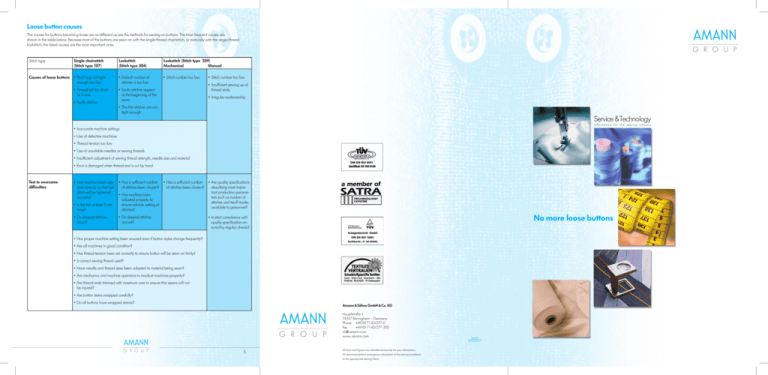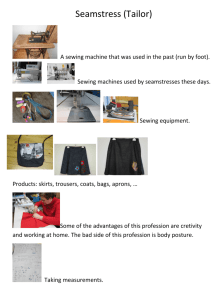No more loose buttons
advertisement

Loose button causes The causes for buttons becoming loose are as different as are the methods for sewing on buttons. The most frequent causes are shown in the table below. Because most of the buttons are sewn on with the single-thread chainstitch, or manually with the single-thread lockstitch, the listed causes are the most important ones. Stitch type Single chainstitch (Stitch type 107) Lockstitch (Stitch type 304) Lockstitch (Stitch type 209) Mechanical Manual Causes of loose buttons • Final loop not tight enough too low • Default number of stitches is too low • Stitch number too low • Thread tail too short (< 3 mm) • Faulty stitches appear at the beginning of the seam • Faulty stitches • Stitch number too low • Insufficient sewing up of thread ends • Irregular workmanship • The first stitches are not tight enough Service & Technology Information for the sewing industry • Inaccurate machine settings • Use of defective machines • Thread tension too low • Use of unsuitable needles or sewing threads • Insufficient adjustment of sewing thread strength, needle size and material • Knot is damaged when thread end is cut by hand Test to overcome difficulties • Has machine been adju- • Has a sufficient number sted correcly so that last of stitches been chosen? stitch will be tightened • Has machine been securely? adjusted properly to • Is the tail at least 3 mm ensure reliable setting of long? stitches? • Do skipped stitches occur? • Has a sufficient number of stitches been chosen? • Do skipped stitches occure? • Are quality specifications describing most important production parameters such as number of stitches and tieoff mode, available to personnel? No more loose buttons • Is strict compliance with quality specification ensured by regular checks? • Has proper machine setting been ensured even if button styles change frequently? • Are all machines in good condition? • Has thread tension been set correctly to ensure button will be sewn on firmly? • Is correct sewing thread used? • Have needle and thread sizes been adapted to material being sewn? • Are mechanics and machine operators to readjust machines properly? • Are thread ends trimmed with maximum care to ensure that seams will not be injured? • Are button stems wrapped carefully? • Do all buttons have wrapped strems? Amann & Söhne GmbH & Co. KG Hauptstraße 1 74357 Bönnigheim – Germany Phone +49 (0) 71 43/277- 0 Fax +49 (0) 71 43/277- 200 nt@amann.com www .amann.com 5 All facts and figures are intended exclusively for your information. All recommendations presuppose adjustment of the sewing conditions to the appropriate sewing fabric. 100029 GB00500117 No more loose buttons Everybody knows the bothersome issue of loose buttons. Even with high-quality products, loose buttons are quite common. While one more or less accepts a lost shirt button with just a shake of the head, the loss of an expensive fashion button will lead to a complaint – especially if there was no extra button attached. In any case, it is expensive for the garment manufacturer. The result will be a loss in image and high costs handling complaints. Consumers do not understand this quality problem. „It can’t be that hard to sew on a button so that it stays, can it?“ If one follows the correct processing guidelines, a firmly sewn on button is no problem. All the important information on sewing on a button to make it last is listed below. Button Variety Buttons not only have functions, they are design elements and fashion accessories too. That is why there is such a great variety of button forms, materials, and sizes. And this is the first problem to be solved with regard to securely sewn on buttons; such a variety requires a great deal of adaptation. The method must be flexible and – considering today’s often small batch sizes – frequently changed. Inaccuracy here leads to an impairment of the sewing process and thus to a less securely sewn button. In addition, they differ: • in size (ligne), • in form (for example, round, oval, rectangular, triangular), • in the distance between the holes, • in thickness, and • in the way their reverse side is moulded (for example concave, convex, or flat) The button sizes are normally indicated by a British measuring unit called ligne (symbol ’’’). This measure indicates: • the diameter of round buttons, and • the distance between the farthest corners of multi-angular buttons Based on the fact that 1 inch (= 25.4 mm) equals 40 ligne, the following table can be used to convert button sizes indicated in ligne into millimetres: Ligne Button dimension (mm) 10 ‘‘‘ 6,35 mm 20 ‘‘‘ 12,70 mm 30 ‘‘‘ 19,05 mm Cutting the thread after sewing The majority of button sewing machines cut the sewing thread with a shearing action. A knife, either arranged below the throat plate or fixed to the sewing hook and performing a backstroke after the sewing process, cuts the thread. Only few button sewing machine types sever the sewing thread while lifting the button clamp. The length of the rest of the thread depends on the method used. With the shearing method, the rest of the thread length depends on the throat plate thickness of at least 3 mm. If the thread is severed by lifting the button clamp, the rest of the thread length is between 0 –1 mm, because the thread breaks right at the knot. Sewing recommendations contained in the filament, the thermo-bonding glues the wrapping together and prevents the button holding threads from loosening during later use. Many garment manufacturers today use this method to secure their buttons. Shirts, blouses, trousers, skirts, coats, jackets, and many other products have been finished with the Ascolite system. The following criteria are the basis for choosing the right sewing thread: • How heavy is the button and how will it be stressed in wear? It is obvious that decorative buttons without any practical function can be sewn on with a finer thread size than buttons used for fastening trousers or jackets, for example. Big and heavy buttons need a thicker sewing thread for a secure hold than smaller and lighter buttons. Wrapping The threads under the button are wrapped to additionally secure the button and for reinforcement. This is to tie up the button threads, and thus provide a long-lasting hold. Buttons with a long “stem” must stand upright and must neither tilt over nor dangle loosely – this is easily achieved by wrapping. Basically, one distinguishes button sewing methods with and without stem wrapping. Classic applica­tions for stem wrapping are 2- and • For which application will it be used? The suitable sewing thread size is determined by the material thickness, model, and product group (women’s, men’s, children’s wear, home textiles, etc.). • Which article or ticket no. is used for the other sewing operations? In favour of a small sewing thread assortment, no extra article should be added for sewing on buttons. 50 ‘‘‘ 31,75 mm 60 ‘‘‘ 38,10 mm Considering these criteria, the following sewing threads from the AMANN product range are generally used for numerous appli­cations: How are buttons sewn on? In addition, the mechanical sewing on of buttons can be differenti­ated by: • the stitch types, • the way the thread is cut after sewing, and • the way the stem is wrapped. Stitch type and looping The zigzag single chainstitch (stitch type 107) is a standard stitch type for sewing on buttons. Technically possible, yet found only rarely in practice, are the zigzag lockstitch (stitch type 304) and the lockstitch (stitch type 209). Under the aspect of the secure sewing on of a button, these stitch types have advantages over the zigzag single chainstitch. Still, they have not prevailed in practice, because they are not competitive with respect to other criteria – machine costs, flexibility, sewing speed, etc. Irrespective of the stitch type, the looping process is impaired when sewing on buttons, because of the lack of feed motion. Because the needle repeatedly pokes into the same stitching hole, practically sewing on the same spot, the looping of the individual stitches happens in a very small area, all very close to each other. Under these circumstances, inaccurate machine settings or an unfavourable combination of needle size and sewing thread strength more easily lead to faulty stitches. Buttons: unlimited creative variety Buttons can be classified into three main groups: • shank buttons, • self-shank buttons, and • two- and four-hole buttons Shank button Source: Ascolite AG Self-shank button 2- and 4-holed button Source: Ascolite AG Short and long stem, shank button Source: Ascolite AG 4-holed buttons for closing jackets and coats, and sleeve buttons with buttonholes. Buttons on shirts and blouses and shank and self-shank buttons are wrapped only seldom in practice. Howewer things seem to have changed over the last few seasons to achieve a longer button life. More and more often, one can see buttons with wrapped stems on shirts. There are two different stem wrapping methods. Besides the standard method with traditional stem wrapping machines using regular sewing thread, the Ascolite system is used frequently. Here, the wrapping is done with specially designed wrapping machines using Ascolite filament. Ascolite special filament is highly elastic and thermo-bondable. Its high elasticity of more than 300 % (traditional sewing threads feature about 20 %), allow high tension wrapping to achieve a best possible clamp­ing effect and an extremely secure stem. After sewing, Ascolite filament tightly wraps around the stem and thus se­curely clasps the button holding threads. Thus, the button is secured yet remains flexible. After activating the melting component Ascolite TF-system Jacket with additional button fixing with Ascolite TF-system Source: Ascolite AG Button Buttons should be produced absolutely precisely. The distanced between the holes and the central position of the holes must be exactly the same with all buttons in order to guarantee perfect processing characteristics. Even little differences can deflect the needle and cause faulty stitches. The buttons must also be free of sharp edges or burrs because these can rub through the thread after only a short use. Needle If you want to improve the fastening of the buttons even more, you should use the Ascolite system (see description on page 119). This additional wrapping of the stem with a special filament has proven its advantages in practice: The Ascolite system provides a clearly improved hold compared with traditional stem wrapping methods or without stem wrapping. For detailed information on this button securing method and to view a fascinating button gallery, visit the website www.ascolite.com. A prerequisite for a trouble-free sewing process is an optimal adjustment of needle, sewing thread, and material. We recommend the following sewing thread /needle combinations: In addition to these recommendations, AMANN has worked out a checklist listing troubleshooting and remedy options. It can be downloaded from www.amann.com. An alternative for sewing on buttons are RASANT cotton corespun threads, which are available in different sizes too. Good order and condition, thorough maintenance, and regular servicing of the machine are the basic requirements for a troublefree sewing process. Of special importance are correct machine settings: The machine should be adjusted to the relevant button form only by trained personnel. Even if the button forms change often, the machine adjustment must be carried out with due care. Modern button sewing machines have additional features for securing the buttons (special locking mechanisms), which are very beneficial. For example, the Pfaff button sewing machine class 3307 has a patented mechanism for double knotting the end stitch. This means maximum security for the thread ends and it prevents the undesirable unravelling of the seam. Replacing old machines with modern ones can therefore be an extremely valuable investment with regard to quality. Sewing on buttons by hand should be avoided, because experience has shown that maintaining a consistent quality level is difficult here. Stem wrapping with the Ascolite system SABAC 80 SABAC 100 SABAC 120 SABAC 150 SABAC 80 SABAC 100 SABAC 120 SABAC 150 Needle Nm 100 Needle Nm 90 Needle Nm 80 or 90 Needle Nm 80 Because the needle can easily be deviated during sewing, with only little power, thin needles (Nm 70 and finer) and needles with short shanks should be used in exceptional cases only. The form of the point of the needle must be adjusted to the material. R or RG points are usually well-suited for all standard materials. In order to guarantee a well-functioning needle, it must be checked frequently and replaced regularly. Inaccurate machine settings or improperly positioned holes in the buttons can easily damage the needle, which should be noticed and repaired immediately. Source: Ascolite AG Service & Technology 2 If there is a problem with loose buttons, any weak points must be precisely analyzed and systematically eliminated. This analysis should check for the above mentioned causes one by one and use the following processing guidelines for optimisation: Sewing thread 40 ‘‘‘ 25,40 mm In practice, different methods are used to sew on buttons. Basically, one can distinguish between the manual and mechanical methods. Sewing machine Service & Technology 3 4






